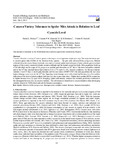| dc.contributor.author | Mutisya, Daniel L | |
| dc.contributor.author | Khamala, CPM | |
| dc.contributor.author | El Banhawy, EM | |
| dc.contributor.author | Kariuki, CW | |
| dc.contributor.author | Ragwa, Silas | |
| dc.date.accessioned | 2013-06-14T07:06:17Z | |
| dc.date.available | 2013-06-14T07:06:17Z | |
| dc.date.issued | 2013 | |
| dc.identifier.citation | Journal of Biology, Agriculture and Healthcare Vol.3, No.5, 2013 | en |
| dc.identifier.issn | 2224-3208 | |
| dc.identifier.uri | http://erepository.uonbi.ac.ke:8080/xmlui/handle/123456789/33563 | |
| dc.description.abstract | Cassava, Manihot esculenta Crantz is grown in the tropics as an important staple root crop. The major herbivore pest is cassava green mite (CGM) of the Mononychellus species. The pest mite Mononychellus progresivus Doreste collected from the coastal Kenya lowlands was used to evaluate spider mite tolerance of nine varieties grown in three regions of the country; eastern lowlands, western midlands and the humid coastal lowlands. Mite population build-up of 10 individual motile stages of M. progresivus reached peak densities on 39th day of the most susceptible varieties and by the 54th day attacked leaves had wilted in 20.0 ± 2 °C and 63 ± 4%, climatic conditions. For the most tolerant varieties it took 47 days to reach peak densities and for one variety (MM97/3567) the mite population did not cause highest damage score even by the 55th day. Equating visual damage score with actual leaf biomass loss (%) enabled indication of the level of photosynthetic leaf area loss due to pest mite attack. Higher leaf cyanide (HCN) content led to higher biomass loss (%) up to HCN 20mg/Kg. Spider mite density increase was similarly positively correlated to the subsequent biomass loss on cassava varieties. This information is beneficial to cassava breeders when developing varieties tolerant to CGM attack and safe for human consumption | en |
| dc.language.iso | en | en |
| dc.subject | Damage score | en |
| dc.subject | Cyanide content | en |
| dc.subject | Biomass | en |
| dc.subject | Human consumption | en |
| dc.subject | Mononychellus progresivus | en |
| dc.title | Cassava Variety Tolerance to Spider Mite Attack in Relation to Leaf Cyanide Level | en |
| dc.type | Article | en |
| local.publisher | KARI-Katumani, Machakos | en |
| local.publisher | Department of Entomology, University of Nairobi, Kenya | en |

